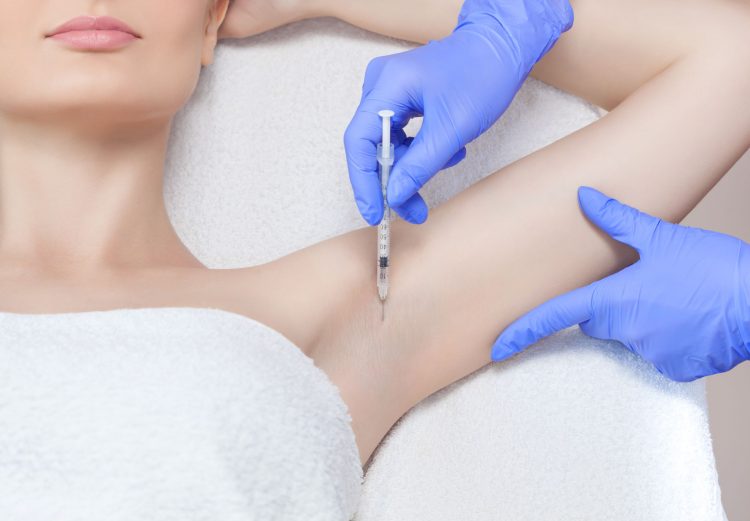Are you wondering about excessive underarm sweating? And, when you need an excessive underarm sweating treatment?
Well, sweating is a normal response. However, excessive sweating can make things worse. It is a condition where the body releases much more sweat. Most often, excessive sweating occurs in various individual parts of the body, including armpits, palms, soles of the feet, face, scalp, and chest. Sometimes, all parts of the body sweat at the same time. This type of sweating is most often associated with some kind of illness or medication. And, general night sweats can be a sign of chronic tonsillitis, tuberculosis, or blood disorders.
Normally, sweating occurs for cooling down the body or controlling the body’s temperature. But, excessive sweating causes shirt stains and body odors, which cause embarrassment and anxiety. As a result, it affects social relationships and even self-esteem.
Many people with hyperhidrosis are embarrassed to seek medical attention, believing that it is impossible to alleviate the symptoms, but this is not the case. Typically, doctors recommend starting with the simplest treatments, such as using an antiperspirant. Further, if it doesn’t work, a medication that blocks the sweat glands is prescribed. And in some cases, severe surgeries and treatments are recommended. Over time, most people see significant improvement.
In this guide, we mention the detailed guide on signs of excessive underarm sweating!
Table of Content
Different Signs of Excessive Sweating
How To Treat Excessive Sweating?
Takeaway!
Different Signs of Excessive Sweating
In some cases, excessive sweating develops in absolutely healthy people and no serious reasons. Some people face the primary excessive sweating caused by a malfunction of the sympathetic nervous system. However, it controls the nervous system and controls most of the body’s unconscious functions, such as heart function, the movement of food through the gastrointestinal tract, the movement of urine from the kidneys to the bladder, and sweating.
The main factor for the occurrence of profuse sweating is the excessive activity of the sympathetic nervous system (SNS), which activates the work of the sweat glands. Furthermore, if the SNS is too active, the sweat glands produce copious amounts of sweat. It is worth considering that the increased activity of the sympathetic nervous system is the mechanism of hyperhidrosis.
Excessive sweating can develop under the following conditions:
- Pregnancy;
- Menopause;
- Anxiety and nervousness;
- Low blood sugar;
- Hyperthyroidism – an overactive thyroid gland;
- Obesity;
- Taking certain medications like antidepressants, tamoxifen, etc.
- Alcohol or drug intoxication;
- Some infections like tuberculosis and AIDS ;
- Parkinson’s disease – a disorder that interferes with the brain’s ability to coordinate movements;
- Diseases that affect the blood cells or bone marrow, such as leukemia or lymphoma.
The water-salt balance is needed to maintain a constant level of electrolytes and ions in the intracellular fluid. Blood plasma also has a salt composition but in a slightly different concentration. So, with an increase in the concentration of salts in the blood plasma and a decrease in the volume of intercellular fluid, the signal is processed by the hypothalamus.
Signs of excessive sweating
The disease is characterized by symptoms of varying severity. There are several levels of severity. Excessive sweating can interfere with daily life and can also cause significant inconvenience. In severe cases, the following symptoms are observed:
- Swelling;
- Pain;
- Redness;
- Constant cooling of the body due to the evaporation of liquid;
- Psychosomatics – problems in society, anxiety, frequent heartbeat.
The symptoms of excessive sweating are very stressful, strong emotionality, warm season, body heat, as well as the use of chocolate, coffee, and certain spices. Many people experience seasonally increased sweating in the spring and summer. Sweating is also associated with activity and stress. Further, the other reason for excessive sweating has surged in hormones and disruptions in the functioning of the autonomic nervous system.
How To Treat Excessive Sweating?
Treatments of excessive sweating carried out through various methods and drugs that lower the intensity of the sweat glands. If sweating is of a secondary type, there are various techniques and methods are used to reduce the problem. Here are the following methods:
- Use of antiperspirants (deodorants, gels, lubricants, wipes).
- Taking drugs that reduce sweating.
- Iontophoresis.
- The introduction of botulinum toxin (botox) into the skin.
- Surgical methods like laser treatment.
All the methods are carried out using a specific algorithm to achieve the desired result. So, if you’re experiencing excessive sweating, it’s time to consult with your doctor.
Takeaway!
Now, you know some major symptoms and signs that lead to excessive sweating. But, there are some effective methods that can lessen this problem. With the help of a reputable dermatologist, you can treat primary hyperhidrosis. But for treating secondary hyperhidrosis, it’s necessary to consult therapists. They will undergo a detailed examination and figure out the actual cause of this phenomenon.
For instance, the doctors of laser therapy, Botox, and dermal fillers in Canberra are experienced and qualified enough to provide the best result. So, always choose a proficient professional for treating excessive sweating issues.




